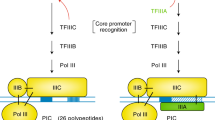Abstract
Ran genes encode a family of well-conserved small nuclear GTPases (Ras-related nuclear proteins), whose function is implicated in both normal cell cycle progression and the transport of RNA and proteins between the nucleus and the cytoplasm. Previous studies of Ran proteins have utilized cell-free systems, yeasts, and cultured mammalian cells. We have now characterized patterns of Ran gene expression in the mouse. Serum starvation suppressed Ran gene transcription in mouse 3T3 cells. Ran mRNA reappeared in cells within 3 h after refeeding. A single Ran mRNA species was detected at low levels in most somatic tissues of the adult mouse. In testis, this Ran mRNA was abundant, as were other larger transcripts. Analysis of testis-derived Ran cDNA clones revealed the presence of two transcripts, one specifying an amino acid sequence identical to that of human Ran/TC4 and one specifying an amino acid sequence 94% identical. Northern blotting and reverse transcriptase-PCR assays with oligonucleotide probes and primers specific for each transcript demonstrated that the isoform identical to Ran/TC4 was expressed in both somatic tissues and testis, while the variant form was transcribed only in testis. The existence of tissue-specific Ran isoforms may help to rationalize the diverse roles suggested for Ran by previous biochemical studies.
Similar content being viewed by others
References
Belhumeur, P., Lee, A., Tam, R., DiPaolo, T., Fortin, N., Clark, M.W. (1993). GSP1 and GSP2, genetic suppressors of the prp20-1 mutant in Saccharomyces cerevisiae: GTP-binding proteins involved in the maintenance of nuclear organization. Mol. Cell. Biol. 13, 2152–2161.
Bischoff, F.R., Ponstingl, H. (1991). Catalysis of guanine nucleotide exchange on Ran by the mitotic regulator RCC1. Nature 354, 80–82.
Bush, J., Cardelli, J. (1993). Molecular cloning and DNA sequence analysis of a Dictyostelium cDNA encoding a Ran/TC4 related GTP binding protein belonging to the ras superfamily. Nucleic Acids Res. 21, 1675.
Coutavas, E.E., Ren, M., Oppenheim, J., D'Eustachio, P., Rush, M.G. (1993). Characterization of proteins that interact with the cell cycle regulatory protein Ran/TC4. Nature 366, 585–587.
Dasso, M. (1993). RCC1 in the cell cycle: the regulator of chromosome condensation takes on new roles. Trends Biochem. Sci. 18, 96–101.
Dissanayke, S., Xu, M., Piessens, W.F. (1992). Filarial parasites contain a ras homolog of the TC4/Ran/Spi1 family. Mol. Biochem. Parasitol. 56, 259–268.
Drivas, G.T., Shih, A., Coutavas, E.E., Rush, M.G., and D'Eustachio, P. (1990). Characterization of four novel RAS-related genes expressed in a human teratocarcinoma cell line. Mol. Cell. Biol. 10, 1793–1798.
Drivas, G.T., Massey, R., Chang, H.-Y., Rush, M.G., D'Eustachio, P. (1991a). Ras-like genes and gene families in the mouse. Mamm. Genome 1, 112–117.
Drivas, G.T., Shih, A., Coutavas, E.E., D'Eustachio, P., Rush, M.G. (1991b). Identification and characterization of a human homolog of the Schizosaccharomyces pombe ras-like gene YPT-3. Oncogene 6, 3–9.
Dupree, P., Olkkonen, V.M., Chavrier, P. (1992). Sequence of a canine cDNA clone encoding a Ran/TC4 GTP-binding protein. Gene 120, 325–326.
Kadowaki, T., Goldfarb, D., Spitz, L.M., Tartakoff, A.M., Ohno, M. (1993). Regulation of RNA processing and transport by a nuclear guanine nucleotide release protein and members of the RAS superfamily. EMBO J. 12, 2929–2937.
Matsumoto, T., Beach, D. (1991). Premature initiation of mitosis in yeast lacking RCC1 or an interacting GTPase. Cell 66, 347–360.
Matsumoto, T., Beach, D. (1993). Interaction of the pim1/spi1 mitotic checkpoint with a protein phosphatase. Mol. Biol. Cell 4, 337–346.
McCombie, W. (1993). Unpublished. GenBank Accession No. T01949.
Moore, M.S., Blobel, G. (1993). The GTP-binding protein Ran/TC4 is required for protein import into the nucleus. Nature 365, 661–663.
Ren, M., Drivas, G., D'Eustachio, P., Rush, M.G. (1993). Ran/TC4: a small nuclear GTP-binding protein that regulates DNA synthesis. J. Cell Biol. 120, 313–323.
Roberge, M. (1992). Checkpoint controls that couple mitosis to completion of DNA replication. Trends Cell Biol 2, 177–181.
Shih, A., Misra, R., Rush, M.G. (1989). Detection of multiple, novel reverse transcriptase coding sequences in human nucleic acids: relation to primate retroviruses. J. Virol. 63, 64–75.
Author information
Authors and Affiliations
Rights and permissions
About this article
Cite this article
Coutavas, E.E., Hsieh, C.M., Ren, M. et al. Tissue-specific expression of Ran isoforms in the mouse. Mammalian Genome 5, 623–628 (1994). https://doi.org/10.1007/BF00411457
Received:
Accepted:
Issue Date:
DOI: https://doi.org/10.1007/BF00411457




